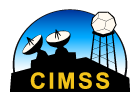On 22 June 2017 a pyroCb formed from the Brian Head Fire in Utah. GOES-15 detected the smoke plumes and pyroCb cloud, as well as the fire hot spot. The pyroCb cloud (~37.7º N, 112.8ºW) formed around 23:30 UTC . Starting at 23:00 UTC on 21 June, the animation below shows GOES-15 0.63 µm visible (left) and 3.9 µm shortwave IR (right) . In the shortwave IR images, the red pixels indicate very hot IR brightness temperatures exhibited by the fire source regions.

GOES-15 0.63 µm visible channel (left) and 3.9 µm shortwave IR channel images (right) (click to play animation)
Usually GOES-15 10.7 μm IR channel data is used to analyze the cloud-top IR brightness temperatures. However, due to the 4-km resolution of the satellite the brightness temperature never reached the -40ºC threshold.A 1-km resolution NOAA-19 AVHRR 10.8 µm Infrared Window image (below;courtesy of René Servranckx) revealed a minimum cloud-top IR brightness temperature of -42.7º C (light blue color enhancement) for the pyroCb.

NOAA-19 AVHRR 0.64 µm visible (top left), 3.7 µm shortwave IR (top right), 10.8 µm IR window (bottom left) and false-color RGB composite image (bottom right)
Suomi NPP OMPS Aerosol Index images (courtesy of Colin Seftor) shows the transport of smoke on 22 June . This max AI was 6.4 at 37.8 N 112.4 W at 20:38 UTC. This is near the source of the pyroCb.

OMPS Aerosol Index image on 22 June
